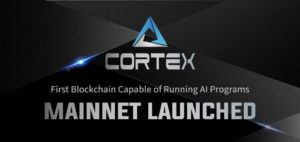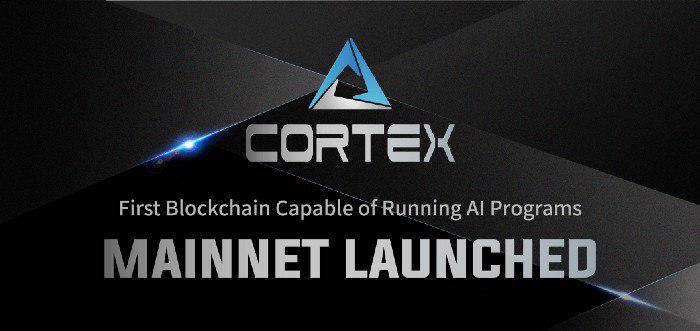
2019-6-28 10:12 |
Cortex Labs, the world’s first team to successfully combine AI and blockchain, has launched its MainNet on schedule after 15 months of innovation and development. The Cortex MainNet arrived on June 26, 6 PM GMT+ 8, thus introducing to the world the first open, public, AI-powered ecosystem. Cortex Labs is on a mission to democratize AI and prevent the creation of AI monopolies, by building an open-source environment to host trained AI models.
For the first time, instead of going through a black box process, users can run AI models on the blockchain in a decentralized, immutable, and transparent manner. Every step of the AI inference process is verified and recorded on the Cortex MainNet.
To facilitate openness and participation, Cortex has also open-sourced all of its code, adding a layer of transparency and inviting developers to explore the blockchain’s potential.
The Cortex AI EcosystemThe Cortex MainNet already hosts 23 AI models trained with four datasets for various real-world applications. The abundance of AI models will constantly expand the use cases for the Cortex network.
With Cortex, each step of the AI inference process is transparent and openly recorded. Centralized algorithms sometimes work as a form of stealth tracking, analysis, and record-keeping but hide their activity. This allows the monopolists to conduct hidden AI activities to further boost its industry dominance with user data. Cortex stands against this monopolistic model, instead proposing the transparent usage of AI.
An open-source, distributed AI environment has many use cases, some of which include:
Decentralized Finance (DeFi): credit report, anti-fraud monitoring for decentralized exchanges, P2P financing, insurance, cryptocurrency lending; Gaming: AI judge, player agent; Carbon Credit Tracking and Trading, including data collection and an immutable blockchain record; Blockchain and Cryptocurrency AI Governance: stablecoins based on machine learning, sentiment analysis, decentralized consensus and voting, malicious behavior detection, smart resource allocation; Miscellaneous: on-chain data mining, facial recognition, recommendation, chatbot, machine translation, voice synthesis.Because the Cortex AI ecosystem is transparent, it is also an antidote against the trend of Deep Fakes. Deep Fakes utilize black-box AIs to create fraudulent images or videos. All AI activities on the Cortex blockchain are recorded and visible for verification – there is no hidden AI at work. The Cortex network can also execute anti-fake AI algorithms to check for video tampering.
Another form of on-chain AI could significantly enhance the user experience for crypto collectibles, for instance achieving unique CryptoKitties behaviors based on previous interactions. There is no limit to the AI use cases, and with the growing community of Cortex, new ideas and approaches are always possible.
Decentralized finance is one of the most perfect matches for AI + blockchain projects. The AI algorithms deployed for finance will be completely traceable, with use cases such as calculating a person’s credit score. Risk management and insurance are yet another area where AI-powered smart contracts can help disrupt the traditional industry.
The Cortex MainNetThe Cortex MainNet is a minable blockchain, utilizing the computational unit Endorphin, similar to the way Gas is used on the Ethereum network. This approach of paying a fee to use the computational capacity of the virtual machine helps to limit spam transactions and also serves as a reward to the miners and the AI model creators.
The Cortex MainNet currently allows about 25.4 transactions per second, hopefully increasing to 1,000 with upgrades. But the most significant achievement is the Cortex Virtual Machine (CVM), the first computational solution that can execute AI programs on-chain. The CVM is also compatible with the Ethereum Virtual Machine (EVM), meaning that it can execute all Ethereum Dapps while incorporating AI algorithms on top.
Cortex uses Cuckoo Cycle, a memory-focused mining algorithm that is suitable for GPU and CPU miners while preventing the accumulation of high-powered ASICs or mining rigs. This approach invites more small-scale miners and creates a more decentralized, community-based network.
What’s Next for CortexThrough the power of the CVM, Cortex allows AI developers to hop on board, offering their trained models to the world. AI developers are rewarded with CTXC tokens in the form of transaction fees for their contribution to the decentralized ecosystem.
The reward mechanism aims to incentivize developers to train and upload better AI models, establishing the foundation for an evolving, decentralized AI ecosystem. The goal of Cortex is to build an openly distributed system of AI models, instead of letting AI models be monopolized by a handful of large corporations.
Developers also have access to Cortex Remix, a browser-based compiler, and IDE for Solidity, the programming language native to the Ethereum and Cortex blockchains. Cortex Remix supports the compilation and deployment of AI smart contracts as well as debugging transactions.
Moving forward, Cortex aims to update the CVM and create a full programming language for its environment. Additionally, the team is working to improve the privacy of the AI models, researching cryptographic solutions to implement shielded on-chain AI inferences. The current plan is to use either technology like ZK-Starks or ZK-Snarks as a layer 1 solution and trusted computing as a layer 2 solution.
Read More:
Whitepaper: https://www.cortexlabs.ai/Cortex_AI_on_Blockchain_EN.pdf
Cortex Forum: https://www.cortexlabs.ai/forum
Twitter: https://twitter.com/CTXCBlockchain
Telegram: https://t.me/CortexOfficialEN
The post AI Goes Full Blockchain with Cortex MainNet Launch appeared first on ZyCrypto.
origin »Cortex (CTXC) на Currencies.ru
|
|
